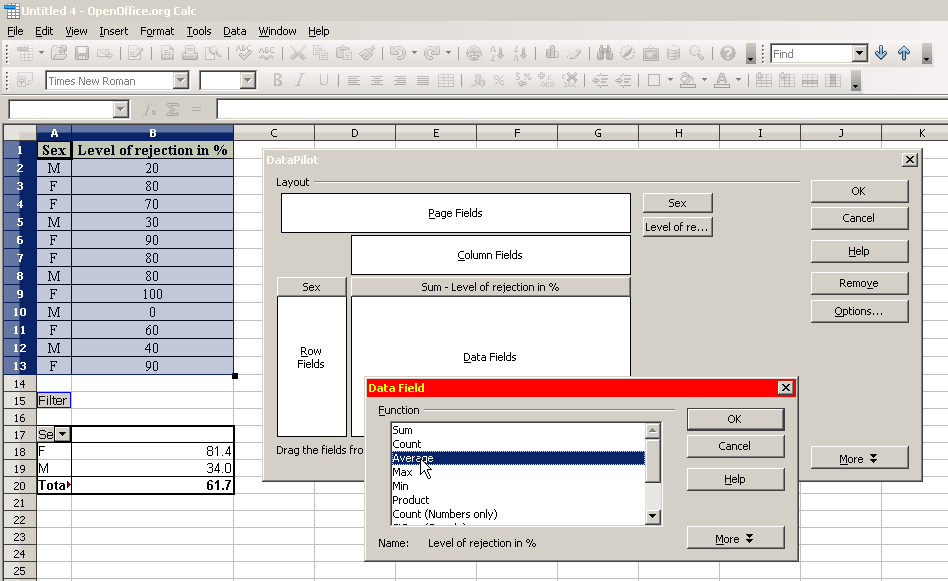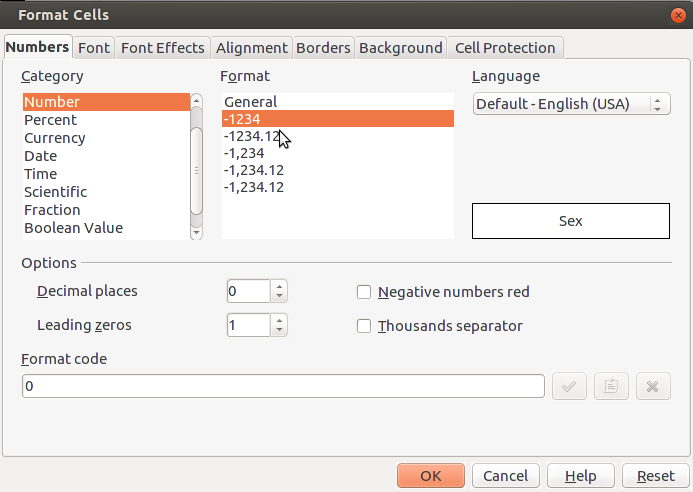Difference between revisions of "Documentation/Writer for Students/Cross Tables"
(Adjusted to revision May 2014) |
|||
| Line 53: | Line 53: | ||
To obtain the summary as displayed in table 5 do the following: | To obtain the summary as displayed in table 5 do the following: | ||
| − | + | <div style="overflow: hidden"> | |
| − | </div> | + | <!--makes text to start after the picture--> |
| − | + | [[File:wfs025_pivot_table.png|none]] | |
| − | + | </div> | |
| − | + | '''Illustration 30: After having dragged the two buttons “Sex” and “Level of …” into their appropriate fields, go to Options and choose Average''' | |
| − | + | ||
| − | + | ||
| − | + | ||
| − | + | ||
| − | + | ||
| + | # Mark the two columns of interest, i.e. “sex” and “extent of rejection” in the raw data table 4, copy them into memory, go to the module Spreadsheet (menu '''File › New › Spreadsheet''') and there insert the contents of computer memory using shortcut '''Ctrl + v'''. | ||
| + | # In your spreadsheet again mark the two columns and go to menu '''Data › DataPilot › Start › Current selection'''. | ||
| + | # Drag and drop the button '''Sex''' onto the white area '''Row Fields''' and '''Level of rejection…''' onto the white area '''Data Fields'''; press '''Options''' and choose '''Average'''; confirm '''OK''' and again '''OK''' (see illustration 30). | ||
| + | # Your new cross table now appears on your spreadsheet. | ||
| + | # Mark it and go to menu '''Format › Cells › Numbers › -1234''' with '''Decimal | ||
| + | place''' value '''0''' and '''Leading zero''' value '''1'''; confirm with '''OK''' (see illustration 31). This way you will avoid decimal places. | ||
| + | # Copy your newly formatted cross table into computer memory ('''Ctrl + c'''). | ||
| + | # Back to your text file insert the contents (as opposed to a direct image) of the cross table using menu '''Edit › Paste Special › Formatted text [RTF]''' (or keyboard shortcut '''Shift + Ctrl + v''' and ''not'' simply '''Ctrl + v''') | ||
| + | # You can now freely format your newly inserted table. | ||
| + | # Finally right click it and add a '''Legend'''. | ||
<div style="overflow: hidden"> | <div style="overflow: hidden"> | ||
| Line 69: | Line 74: | ||
[[File:wfs026_number_decimal_places.png|none]] | [[File:wfs026_number_decimal_places.png|none]] | ||
</div> | </div> | ||
| − | + | '''Illustration 31: The number of decimal places is reduced to 1''' | |
| − | '''Illustration | + | |
== Example of survey involving yes/no answers == | == Example of survey involving yes/no answers == | ||
Revision as of 12:59, 9 June 2014
- Introduction
- Theory
- Document Structure
- Chapter Headings
- Chapter Numbering
- Table of Contents
- Outline
- Navigator
- Text Body
- Paragraph styles overview
- Reusing styles
- Default Page Formatting
- Title Page
- Papers without a Title Page
- Pages with and without numbering
- Roman Page Numbering
- Group Work
- Proofreading
- Numbered lists and bullets
- Line numbering
- Cross-references
- Footnotes
- Bibliography
- Quotes
- Tables
- Charts
- Pictures
- Snapshots
- Presentations & Graphics
- Cross tables (Statistics)
- Extra Long Web Adresses
- Fonts
- Emphasis
- Special Characters
- Non separable combinations
- Shortcut keys
- Mouse clicks
- PDFs
- Saving your files
- Several files open at once
- Search and replace
- Spell Check
- Synonyms
- Document Infos
- Labels and Form letters
- Help
- Installing Program
- Microsoft Word
- Practice I
- Practice II
Apache OpenOffice Calc is perhaps not in league with specialised statistics’ programmes like SPSS or its very recommendable cost free and open source alternative PSPP. Nevertheless you can use it for statistical purposes, one of the most popular being Cross Tables to illustrate the (presumed) dependency of one variable upon another.
Example of survey using two categories and percentages
In a fictional survey we asked 12 people, men and women, to tell us on a scale from 1 to 10 how much they abhorred violent videos. The aim was to see if there is any significant variance between women and men. The raw results are listed in table 4 and the dependencies in cross table 5.
| Questionnaire | Sex | Level of rejection in % |
|---|---|---|
| 1 | M | 20 |
| 2 | F | 80 |
| 3 | F | 70 |
| 4 | M | 30 |
| 5 | F | 90 |
| 6 | F | 80 |
| 7 | M | 80 |
| 8 | F | 100 |
| 9 | M | 0 |
| 10 | F | 60 |
| 11 | M | 40 |
| 12 | F | 90 |
Table 4: Degree of aversion amongst men and women towards violent videos
| Sex | Level of rejection in % |
|---|---|
| F | 81 |
| M | 34 |
| Total | 62 |
Table 5: Same data as above in form of cross table showing that women reject violent videos to a greater degree than men (or pretend to do so)
To obtain the summary as displayed in table 5 do the following:
Illustration 30: After having dragged the two buttons “Sex” and “Level of …” into their appropriate fields, go to Options and choose Average
- Mark the two columns of interest, i.e. “sex” and “extent of rejection” in the raw data table 4, copy them into memory, go to the module Spreadsheet (menu File › New › Spreadsheet) and there insert the contents of computer memory using shortcut Ctrl + v.
- In your spreadsheet again mark the two columns and go to menu Data › DataPilot › Start › Current selection.
- Drag and drop the button Sex onto the white area Row Fields and Level of rejection… onto the white area Data Fields; press Options and choose Average; confirm OK and again OK (see illustration 30).
- Your new cross table now appears on your spreadsheet.
- Mark it and go to menu Format › Cells › Numbers › -1234 with Decimal
place value 0 and Leading zero value 1; confirm with OK (see illustration 31). This way you will avoid decimal places.
- Copy your newly formatted cross table into computer memory (Ctrl + c).
- Back to your text file insert the contents (as opposed to a direct image) of the cross table using menu Edit › Paste Special › Formatted text [RTF] (or keyboard shortcut Shift + Ctrl + v and not simply Ctrl + v)
- You can now freely format your newly inserted table.
- Finally right click it and add a Legend.
Illustration 31: The number of decimal places is reduced to 1
Example of survey involving yes/no answers
If it had been a Yes/No survey, for example to the question “are you mainly right or left handed?”, as in table 7, then you’d do the following:
- Copy the two right columns “sex” and “handedness” from the raw data in table 7 into memory and insert them into your spreadsheet.
- In your spreadsheet again mark these same two columns and go to the menu Data › DataPilot › Start and confirm Current Selection.
- Drag & Drop the button “Sex” onto the white area Row Fields.
- Drag & Drop the button “Handedness” onto the white area Column Fields and also onto the white area Data Fields.
- Under Options choose Count instead of Sum and press More and there choose as Type the option % of row.
- Copy the resulting Cross Table into computer memory.
- Back in your text file insert the contents of computer memory using the keyboard shortcut Shift + Ctrl + v and choose the option Formatted text [RTF] (so as to obtain a formatable table)
| Sex | Left handedness | Right handedness |
|---|---|---|
| Women | 14% | 86$ |
| Men | 60% | 40% |
| Total Result | 33% | 67% |
Table 6: Cross table comparison as to handedness dependent on sex
| Questionnaire | Sex | Handedness |
|---|---|---|
| 1 | M | R |
| 2 | F | R |
| 3 | F | L |
| 4 | M | R |
| 5 | F | R |
| 6 | F | R |
| 7 | M | L |
| 8 | F | R |
| 9 | M | L |
| 10 | F | R |
| 11 | M | L |
| 12 | F | R |
Table 7: Right- and Left-Handedness and Sex (raw data)

